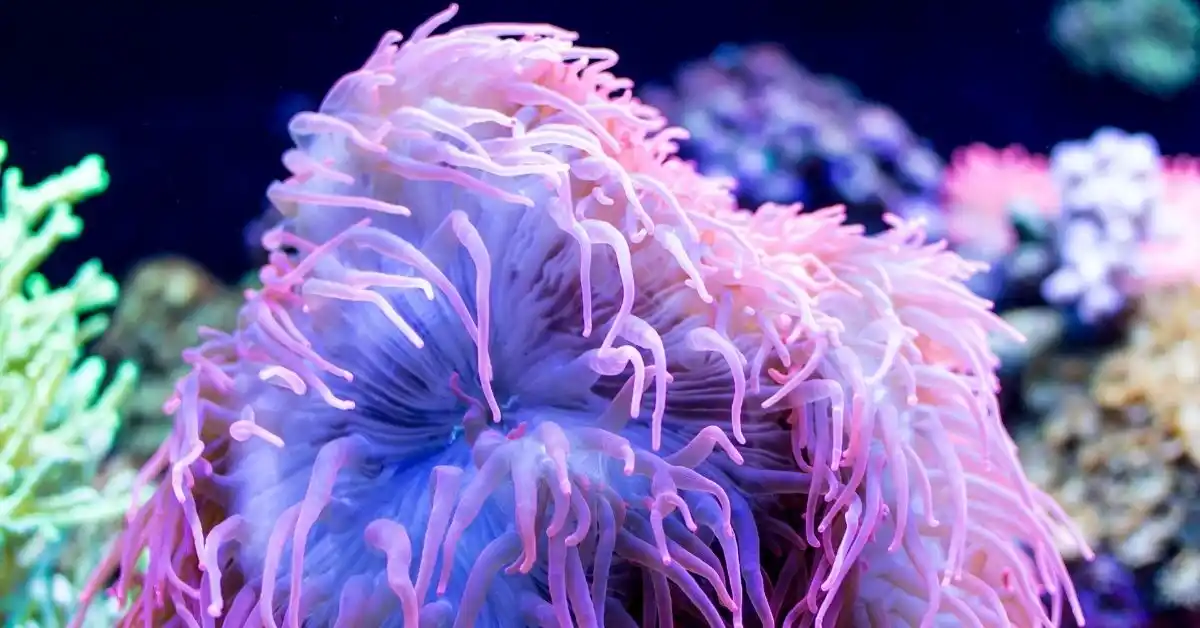Being an aquarist is no easy job. And most of the time, we are confused about the plants and fish in the aquarium.
This is why you might be confused when you see your anemone splitting.
Why do anemones split?
The main reason for anemones’ splitting is their survival instinct. When the anemone senses a threat, it separates.
Poor water quality or, more often, a lack of food is the reason for this. When it thinks the present situation is threatening, it separates.
This is because two tiny ones have a higher chance of surviving than one larger one.
Still don’t understand why your beautiful huge anemone is splitting? Well, don’t you worry. We have a full piece dedicated to this topic.
Why Do Your Anemones Split?
If you’re an aquarium hobbyist, you’re no stranger to anemones. Imagine your clownfish is showing blackspots, you’ll be extremely confused.
In the same way, if you see your anemone splitting into two, you can get anxious.
An anemone can separate for one of two causes. One is beneficial, while the other is detrimental.
Self-protection
When the anemone senses a threat, it separates. Poor water quality or malnutrition is often the reason for this.
Other than that, improper lighting can also threaten the anemone. And when situations are unfavorable, it separates as a kind of protection.
Because, according to them, two tiny ones can survive more easily than one larger one.
So, to prevent this from happening, you’ve to feed the anemone properly. Then provide better water quality. You can do it by knowing about water parameters in fish tanks.
Also, make sure to provide good lighting. You can use low-light LED strips. Here are some of our preferred stips-
Reproduction
If the conditions are right and the anemone has additional energy. Then it will use it to produce a duplicate to promote the species.
Anemones may reproduce both sexually and asexually. Fission is the most common method. This implies they divide in two to generate a clone from the foot or mouth.
Although, like twins, the clone itself is a separate animal. BTAs are also known to mouth brood.
Anemones can also multiply. So, don’t be concerned if you see some other weird way they’re splitting.
How To Tell If Anemones Are Splitting?
If you see your bubble tip anemone dying, you can get depressed. Your anemones splitting creates a similar situation.
Now, you might be asking yourself another question. That is how you would know that your anemone is splitting.
When an anemone expands faster than usual, this is a symptom of splitting. It can also expand horizontally into an oval or figure 8 shape. That is when its mouth is extended out further than normal.
However, there are no telltale signals that an anemone is ready to split.
Usually, they spit three times every five years. During the day, it will go back behind its rock, and at nightfall, it will divide.
Still, confused about the entire splitting process? No worries, friend! We’ve discussed the whole splitting process for you-
- First, the anemone attaches the most basal part of its body to a surface (Rock).
- Once secured, it stretches into an hourglass or the number 8 shape.
- While it’s stretching, its tissue starts separating at an area that’s the narrowest.
- The stretching generally continues from the part attached to the aquarium rock. And it separates up to the mouth.
- The last body part to separate is called the “sphincter muscle.” This is around the mouth.
- After the separation is completed, each small part folds into itself. This occurs where the edges get together to conduct a healing process.
So, that’s it!
The healing process happens when the split anemones can regenerate internal structures that are damaged or missing.
Also, the DNA of the clone is the same so you’ll see no differences.
How To Know If The Split Anemones Are Healthy?
Of course, after such a process, you’d wonder if the anemones are okay. Well, you can be sure by observing the anemones.
The anemones will showcase symptoms if they aren’t healthy. They are mentioned below-
- The color of one or both anemones is off. They might often turn white.
- The body or tentacles have shrunk.
- The anemones have no appetite.
- One or both anemones aren’t engaging in any activities.
So, these are the symptoms of your anemones having issues. The issues or symptoms mainly occur because of lighting and temperature problems.
Simply put, the split anemones are having trouble adjusting to the tank environment. So, wait for them to adjust to the environment.
Once they have adjusted, you can upgrade your bio cube LED if you have one. This will ensure better growth.
FAQs
Question: When an anemone splits, how long would it need?
Answer: A sea anemone might take up to 24 hours to divide. As a result, it might take a few hours or a day. It might take three to five days to observe anemones separating in the wild.
However, this is dependent on several parameters. These include the timing of reproduction, environmental stress, and maturity.
Question: When an anemone splits, how long does it take for it to recover?
Answer: An anemone will usually take 10 days to heal. However, it is seen on many anemones to take much longer to heal.
This can depend on the water conditions in your tank.
Question: How to know if my anemone is dying?
Answer: Take a glance at the mouth of the anemone. Dying anemones open their jaws, giving the impression that the animal’s interiors are spilling outward.
Examine the tentacles of the anemone. They should not be compressed for more than a few minutes.
Conclusion
By now you should have full knowledge of why anemones split. Now, splitting and dying for an anemone sometimes look the same.
But with our mentioned info, you’ll know exactly what is happening with your anemone.


